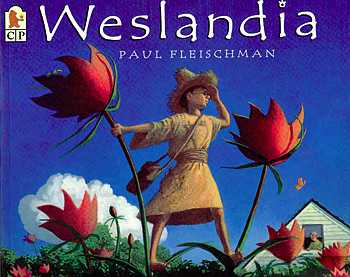Written By: Paul Fleischman
Illustrated By: Kevin Hawkes
Wesley is an outcast from the civilization around him. He does not like pizza or soda, he thinks professional football is stupid, and he refuses to shave half his head like the other boys have done. His parents are worried about him, but Wesley has accepted the fact that he is different, and does not care what other people think of him. As a result of a summer project, Wesley ends up creating his very own civilization, which he rightfully names, Weslandia. Through it all, Wesley proves that it is all right to be different.
Fleischman’s creativity is richly evident in this picture book that opens our eyes to the world of fantasy. Fleischman’s descriptive style allows readers to create vivid images in their mind. For example, he describes Wesley’s newly created clothing as, “Unlike jeans, which he found scratchy and heavy, the robe was comfortable, reflected the sun, and offered myriad opportunities for pockets.” He also notes the change and curiosity in Wesley’s tormenters, “His schoolmates were scornful, then curious. Grudgingly, Wesley allowed them ten minutes apiece at his mortar, crushing the plant’s seeds to collect the oil.”
Illustrator Kevin Hawkes, who also pairs with Fleischman in the creation of Sidewalk Circus, creates full-bleed, double-paged spread illustrations that are saturated with vivid colors. Bright shades of orange, yellow, green, red, and blue jump off the page and bring the illustrations to life. Just like in Sidewalk Circus, Hawkes brings our attention to different perspectives. For example, in the beginning of the story we are invited to watch the magic begin as seeds blow into Wesley’s newly plotted yard. The moving curtains, light, and trees give us the sense of movement and we sense that the story will unfold. As Wesley’s civilization begins to develop, we are insiders to all of the fascinating secrets of Weslandia. We feel as though we are sitting amongst the tall stems of the plants right along with Wesley. Throughout the entire story, the illustrations help us to sense Wesley’s happiness and success.
At the end of the story, we find that Wesley has created a new language complete with an 80-letter alphabet. We can see that Hawkes has clued us in to this special language with an emphasis on the number eight by illustrating the endpages in what we can only assume is the Weslandian language.
Once again, Fleischman shows his versatility as an author as he takes readers through the eventful journey of a boy who everyone will come to admire. It was interesting to find out on Fleischman’s website how his childhood related to Wesley’s. Fleischman does relate to Wesley on some levels. He did feel different from his peers because he was the shortest boy in his class all the way through tenth grade. He also made up an alternate world with his friends—just like Wesley. Unlike Wesley, however, Fleischman says that he wasn’t an outcast and had a great group of friends. Regardless of how Fleischman’s inspiration of Weslandia came to be, this imaginative story captures the attention of all those who read it.

No comments:
Post a Comment